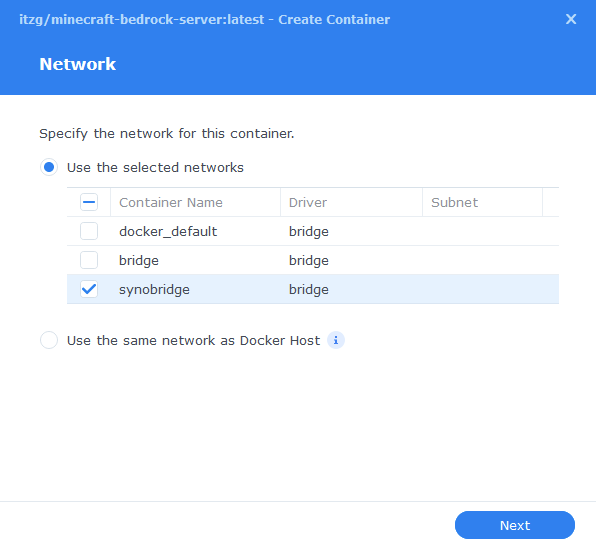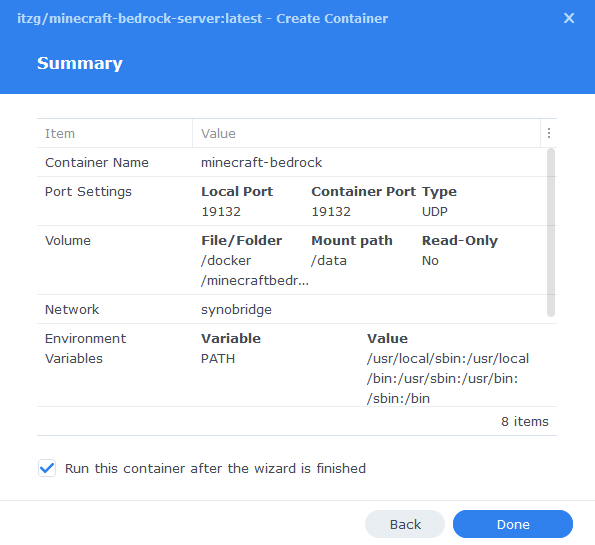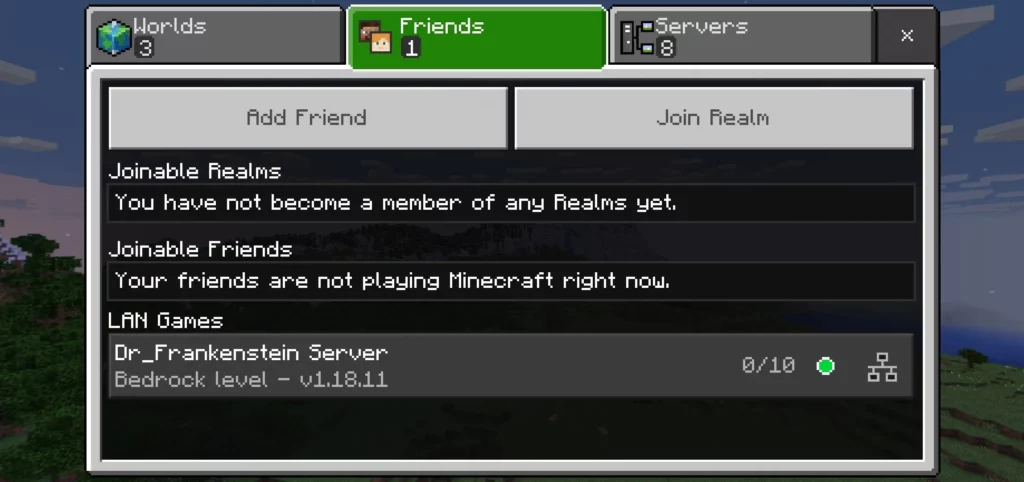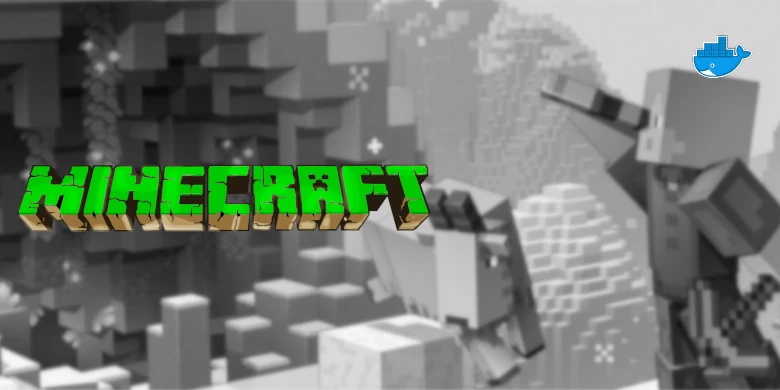Please note if you are using DSM7.2 or higher you should use the Container Manager version of this guide from the menu.
If you are still using an older DSM version migrate to Dockge and you can use my new guides!
See the Dockge guide here to start migration!
This guide has reached the end of its updates
| Update | Date |
|---|---|
| Due to an upstream issue/change the method to add people to the allow list has changed – guide updated to reflect this (See the compose and notes below) Also added a new section on how to open up Remote Play using your own address. | 20/08/2023 |
In this guide I am going to take you through the steps to get a Minecraft Bedrock server up and running in Docker on a Synology NAS.
What is the Bedrock Edition?
The Bedrock edition is the version used by all consoles such as the Nintendo Switch, Android, iPhone, and the Windows store edition. If you are looking for a JAVA edition see my other guide.
In order for you to successfully use this guide please complete the two additional steps below
Downloading the Container
Open up Docker within DSM and navigate to the ‘Registry’ tab and search for ITZG in the keyword box.

Within the results right click and download the ‘ITZG|Minecraft-Bedrock-Server’, When it asks which version number to download select ‘Latest’
Setting up the container
Now we have downloaded the container and got hold of our user IDs we can move onto the next stage.
Go back into Docker and click on the ‘Image’ tab, in the list of your containers select the ITZG minecraft bedrock server, and click on ‘Launch’

You will be greeted with the Network screen, we will be using the bridge network, this allows us to specify the ports we want to use.

Next you will be greeted with the General Settings screen, this is where you can start specifying some of your preferences.
You can change the name of the container to anything you like, and you may want to enable Auto Restart as this will ensure the server starts automatically if you reboot your NAS.
We won’t be change any of the other settings.

Next up we are going to click on the ‘Advanced Settings’ button, this will take you to a new window with a number of tabs which we are going to work through.
Environment
We are now going to set up the specific options for the server some of these will be set based on your preference.
Add each of the values below by clicking the ‘Add’ button at the top of the screen and then entering each of the values below.
These are the minimum settings I would use, you can see a full list on ITZG’s GitHub including how to give permissions to your users. Take note that some items are UPPERCASE and some are lowercase. This is how they should be set.
| Variable | Value | Comment/options |
|---|---|---|
| UID | YOURUID | UID you obtained earlier |
| GID | YOURGID | GID you obtained earlier |
| EULA | true | This accepts the Minecraft EULA, without this the server will not run |
| VERSION | latest | This keeps the server updated to the latest release. You can also change this to a specific version such as 1.18.10 which is useful if Microsoft updates the server version before releasing new clients! |
| SERVER_NAME | Give your server a name | |
| SERVER_PORT | 19132 | don’t change this |
| GAMEMODE | creative, survival, adventure | |
| DIFFICULTY | peaceful, easy, normal, hard | |
| ONLINE_MODE | true or false (true will require you to be signed in to Xbox Live when playing) | |
| OPS | yourxuid | In order to get your xuid you will need to visit this site enter your xbox/microsoft gamertag and select decimal (DEC) in the options |
| WHITE_LIST | true / false | see the section further on in the guide for the steps to add people to the White List |
Links / Execution Command
You do not need to set up anything on these tabs.
Press ‘Save’ to go back to the initial setup screen, then press ‘Next’
Port Settings
On this screen enter 19132 in the left-hand side of the page in the Local Port section and then click Next

Volume Settings
We can now specify the directory where Minecraft will store its configuration files.
Click on Add Folder, click on the docker folder and create a new sub-folder called ‘minecraftbedrock’ select this folder and click ‘select’

Now we need to specify where this folder will be mounted inside the container. As per the screenshot/table below, enter /data into the ‘Mount path’.
| File/Folder | Mount path |
|---|---|
| docker/minecraftbedrock | /data |

Click on Next and you will be taken to an overall summary screen, just do a quick sanity check to make sure they are correct. If you want to launch the server immediately check the box and click on Done.

Adding People to the White List
We can now add additional people to the White List otherwise you will get errors when they attempt to connect
Open up Docker and within the Container list select the Bedrock Server and click Details.

On the Terminal that appears type allowlist add then the exact name of the Friend you want to add including any Capital letters and press Enter.

Connecting to the Server
There are two ways to connect to the server, either via the Friends tab or by adding it manually to the Servers tab in Minecraft. Using your NAS IP:19132

(Optional Extra for Remote Play)
So your friends have an easy way to play remotely lets set up an address for them to connect to, please note that the section below opens port 443 however you will also need to forward port 19132.
External Access
You have some choices when it comes to making your new container accessible from outside your home network, these come with different levels of security and convenience. This mini section is generic but covers the basics of getting this guide up and running and is entirely optional.
- Synology’s DDNS (Dynamic Domain Name System) with a TLS Certificate and Reverse Proxy
This is useful if you have some family members or friends that need access to something like Overseerr or Jellyseer and is covered below. - Tailscale or Wireguard VPN
If just you or close family in your household are accessing these services, and you don’t want to expose them to the internet this would be the more secure choice. See my other separate guides. - Cloudflare Tunnels
I don’t currently use these, so I would recommend watching the Wundertech guide on how they work.
A note on Double NAT or CGNAT
Unfortunately more ISPs are moving to these methods of address allocation as the IPv4 address space is getting low on available addresses. If your ISP is doing this your choices are more limited.
You can test if this is the case by checking the WAN IP on your Router/Modem settings and then comparing it to the one shown on portchecker.co. If they are different you are likely Double NAT and will either need to see if you can pay your ISP for a standard IPv4 address or use Tailscale or Cloudflare Tunnels for access.
Using the built-in tools on DSM
The first step of this process is to forward port 443 on your Router to your NAS IP Address, how you do this will depend on your router model, so please refer to its manual.
Router (External):443 > NASIP (Internal):443
Next make sure you have registered for a Synology Account as we are going to be using their DDNS service. https://account.synology.com/en-uk/register/ If you already have this set up move to the next step.
DDNS (Dynamic Domain Name System)
A DDNS address allows you to get external access to your container via an address provided by Synology, this is useful on home internet connections where your ISP will change your IP address on a semi-regular basis.
In the DSM Control panel go to ‘External Access’ and then to the ‘DDNS’ tab

Click on ‘Add’, then fill out the following sections.
| Section | Value |
|---|---|
| Service Provider | Synology |
| Hostname | This will be the unique address just for you so keep the name generic. minecraft.synology.me = BAD myawesomenas.synology,me =GOOD |
| Email: | Log into your Synology account |
| External Address (IPv4) | This should be filled in automatically |
| External Address (IPv6) | This should be filled in automatically if your ISP is using IPv6 |
| Get a Cert from Let’s Encrypt | Tick this box |
| Enable Heartbeat | Tick this box |
Now press OK, DSM will apply your settings. It can take a few moments to set up and the DSM interface will refresh. You will likely receive a certificate error which you will need to accept to get back into DSM.
Reverse Proxy
We are going to set up a reverse proxy subdomain for the address you just register. This means you and your users can access the container without using a port number as it will route all traffic through the secure 443 port.
Go back into the Control Panel and access the ‘Login Portal’ then in the ‘Advanced’ tab click ‘Reverse Proxy’ and then click on ‘Create’.

We are now going to enter some rules, so when you or your users access the URL specified the request will automatically be sent to the containers web UI.
Use the settings below, you will need to amend the Hostname sections in line with the hostname you registered earlier, and the IP of your NAS.
| Setting | Value |
|---|---|
| Reverse Proxy Name: | Give it a meaningful name in line with the container you are setting up. |
| Protocol: | HTTPS |
| Hostname: | containername.xxx.synology.me ‘containername‘ will be the name you want to use to access this container ‘.xxx.synology.me‘ will be the exact name you registered earlier |
| Port: | 443 |
| Protocol: | HTTP |
| Hostname: | ‘localhost’ or your NAS IP address |
| Port: | The UI Port Number from the yaml in the guide you are following |
On the second tab ‘Custom Header’ click on Create then WebSocket, this will add two entries for WebSockets to function correctly, you can now press save.

You should now be able to access the web UI of the container by going to the address you just set up in the reverse proxy, it will be a secure connection, and you should have no certificate errors.
| Historic Updates | Date |
|---|---|
| New guide released | 23/02/2022 |
| DSM7.1 Update with new screenshots and steps | 27/05/2022 |
| Added some other useful variables to get the basics setup on a server | 23/06/2022 |
| Added new port settings and Docker Bridge Network | 23/07/2022 |
| Compose version number removed and small wording amendments | 09/04/2023 |
Looking for some help, join our Discord community
If you are struggling with any steps in the guides or looking to branch out into other containers join our Discord community!
Buy me a beverage!
If you have found my site useful please consider pinging me a tip as it helps cover the cost of running things or just lets me stay hydrated. Plus 10% goes to the devs of the apps I do guides for every year.




Hi, I followed your guide, but the server doesn’t start. It seems that the download has an issue. Which permission is missing?
Do you have any idea?
2023-03-05T08:16:20.897230974Z stdout Double check that the given VERSION is valid
2023-03-05T08:16:20.896970997Z stdout ERROR failed to download from https://minecraft.azureedge.net/bin-linux/bedrock-server-1.19.63.01.zip
2023-03-05T08:16:20.893063195Z stdout curl: (23) Failure writing output to destination
2023-03-05T08:16:20.747470908Z stdout Downloading Bedrock server version 1.19.63.01 …
2023-03-05T08:16:19.998179291Z stdout Looking up latest version…
Hey – It might be worth just downloading the zip file it references and unpack it directly to the bedrock folder – must have been a temporary issue?
Hi, I’ve extracted the zip manually in /docker/minecraftbedrock/, but it still shows the same issue.
Going to ping you an email as could do with seeing your Environment variables and a full copy of the log
Can multiple docker containers be created to host multiple Minecraft bedrock worlds on the same server? Could you show an example?
Hey yes definitely!
Two key things would be changed.
1) Create a different folder for each server the ‘Mount Path’ will still be /data
2) Then you will need to assign a different ‘local port’ you could just increment it to 19133 for example, but the ‘container port’ will remain the same
Hello! Thanks so much for your guide. A few questions though. To reach the server externally, does the user use the ip address of the server? Or the gateway address we setup in docker in your other guide? Then for the ports, on that ip address do I need to open 19132? Thanks for the help!
Hey, I am going to be adding the reverse proxy section to both the Minecraft guides in due course.
Yes if you already have a ddns address set up you will set a Reverse Proxy address such as minecraft.samb.synology.me pointing at port 19132
Okay complete honesty I have no idea what this means. So I know I have to port forward 19132, but what is the ip address of the server? Ik its different for everyone but is it the ip address within the browser address when I connect to synology?
Ping me a message via my help page on the top of the menu will come back with the steps.
Would you happen to know what permission needs to be set for this error? The image appears to start and crash within a minute of starting.
DEBU[0000] Using /data to match uid and gid
DEBU[0000] Resolved 1031 from environment variable UID
DEBU[0000] Resolved 100 from environment variable GID
Looking up latest version…
/opt/bedrock-entry.sh: line 51: restify.err: Permission denied
/opt/bedrock-entry.sh: line 51: restify.err: Permission denied
/opt/bedrock-entry.sh: line 51: restify.err: Permission denied
I’ve created the dockerlimited user following your instructions, and have the file structure nearly identical to your instructions (I replaced /data with /DrData). I did notice that my /docker/minecraftbedrock dir appears to be empty currently. Thanks in advance!
Hey, so it sounds like you slightly went off the beaten track 🙂
If you stop the container and edit the Volumes settings again and make it exactly as the guide suggests. The /data directory in the case of this guide is the name of the folder within the container which it uses to put the server files, this is mounted to /docker/minecraftbedrock
Amend that and you will be good.
Haha yes, guilty. I was following your Step 1: Directory Setup Guide, and created /DrData instead of /data, since I already had a /Data directory that I didn’t want to re-use. I followed all those steps, and also made sure to point the Mount Path to that /DrData shared folder, since that’s where the dockerlimited user has RW permissions. I thought that should work?
I also tried changing it to /data, but ran into the same error. It looks like the error is thrown from line 51 here: https://github.com/itzg/docker-minecraft-bedrock-server/blob/master/bedrock-entry.sh but I’m not entirely sure why. Is it having execute permission issues on something trying to get the download URL?
Hey, can you ping me screenshots of the volume tab and environment tabs of the docker UI please
https://images.drfrankenstein.co.uk/ (username=upload password=me)
Done! There were a few variable/values (ops, WHITE_LIST_USERS, cheats) that aren’t in the screenshot because I couldn’t expand the Advanced Settings window, but I don’t think they should affect the issue. Thanks for the help!
Hey thanks, so this is the part you have changed incorrectly and needs to be set exactly as shown in this screenshot here.
https://drfrankenstein.co.uk/wp-content/uploads/2022/05/image-20.png
Oh, that’s what I mentioned in a post above, where I had followed your Step 1: Directory Setup Guide:
“With this setup all of your media will sit within a single share, you can call this whatever you want but in all the guides it will be called ‘data’. If you change its name you will need to adjust any steps or compose files from my guides accordingly.”
I chose to use /DrData while setting up the directory/permissions for the dockerlimited user instead of /data, since I already had an existing /Data folder that I didn’t want to mix in with this bedrock server. Do you know if there is something hardcoded into the setup that it must be /data? Or should it work correctly as long as I have /DrData permissioned corrrectly?
I did also change that Volume Setting value to /data and still encountered the same error, so it seems like it’s another issue, I’m just not sure what permission is missing, or if perhaps some files are missing. Thanks!
You don’t require the /data (DrData) share for this tutorial as the config for this solely lives in the /docker share, we don’t mount the other one at all here and not included in the initial setup steps, so don’t worry about that part.
Keep the settings as shown in the screenshot in the guide, however it does sound like a permission issue – can you delete the /docker/minecraftbedrock folder and create it again using filestation. Then run the container again. If it still doesn’t work can you reach out to me via Discord or via my contact page (below my logo) thanks.
I found the issue for that error. I had incorrectly ordered the new firewall rule that was created during your networking bridge setup steps, so it was blocked by a Deny All rule I had from a previous unrelated set of setup steps. Sorry for having you hunt around through that. That fixes the restify error now. I do get a new set of errors, but these at least appear to just be some directory permissions. I’ll keep digging!
Downloading Bedrock server version 1.19.51.01 …
error: cannot create allowlist.json
Permission denied
error: cannot create bedrock_server
Permission denied
error: cannot create bedrock_server_how_to.html
Permission denied
error: cannot create bedrock_server_symbols.debug
Permission denied
checkdir error: cannot create behavior_packs
Permission denied
unable to process behavior_packs/.
Thank you so much for the great guide – I finally got a server running on our DiskStation. It works perfectly on the local network but not externally. I’ve tried forwarding port 19132 to the IP of the NAS, but that hasn’t helped. I suspect that I should either forward other ports or that it might be related to the bridge network setup (172.20.0.0/16) being different from the actual LAN-subnet (192.168.0.0/16). Any help would be much appreciated.
Hi – What URL are you using for the external connection, is it something like jacok.dscloud.me:19132 – The Docker bridge is purely for the networking within Docker it has no effect on the overlaying LAN subnet.
For the test I just used the WAN IP-address and port 19132 – like 1.2.3.4:19132.
Test to see if the port is actually open on https://portchecker.co/
It wasn’t and I’ve tried quite a bit of changes to no avail. On my ASUS router I’ve set port forwarding for 19132 to my Synology NAS, but that doesn’t seem to cut it. There is access from WAN to the admin-port of the router. That seems to indicate that the lack of access on 19132 is due to something on the NAS – but that firewall also allows the port.
Any ideas?
Thank you!
Never mind my last post – now it works for some reason 🙂
Ha – I was just typing a response so it must of known 🙂